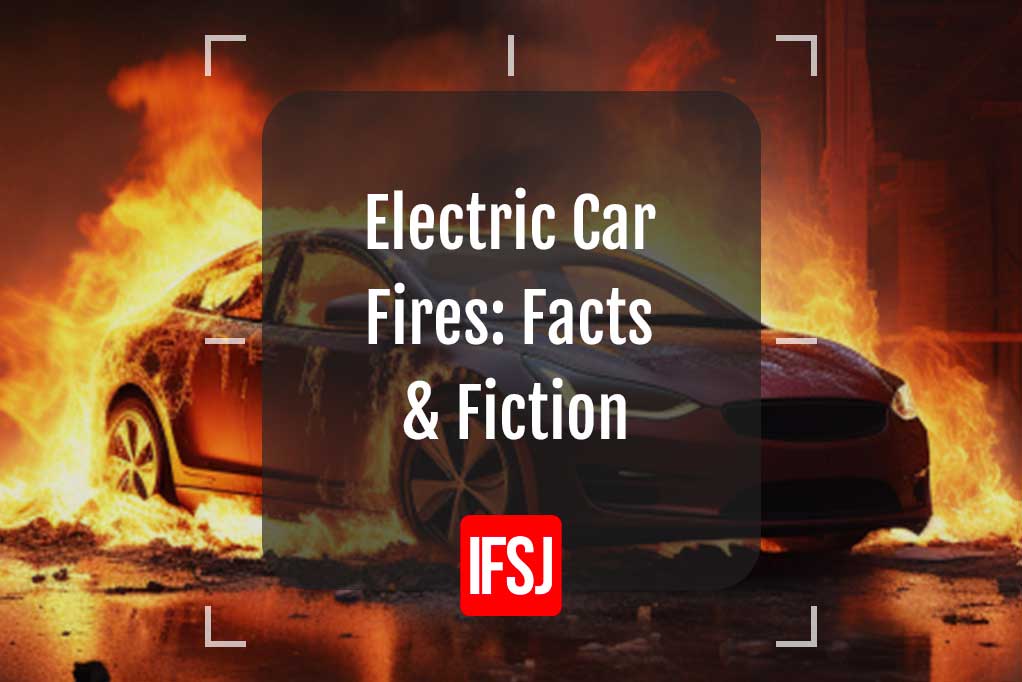Electric Car Fires – Facts & Fiction
- December 7, 2023
- 9:00 am


Simon Burge
Share this content
Electric cars have become a hot topic, quite literally, in recent years.
With the rise of these eco-friendly vehicles, myths and misconceptions about their safety have also surfaced.
One of the most prevalent concerns revolves around electric car fires.
In this article, we’ll debunk the myths and shed light on the actual facts about electric car fires.
The Myths of Electric Car Fires
Electric Car Fires are Impossible to Put Out

One widespread myth is that electric car fires cannot be extinguished easily.
This fear stems from the complex nature of electric vehicles, particularly their intricate battery systems.
However, it’s crucial to understand that modern firefighting techniques have evolved significantly to cope with these challenges.
Firefighters today undergo rigorous training, equipping them with specific protocols and advanced tools designed explicitly for electric vehicle fires.
These tools include specialised cooling methods that help dissipate the heat generated during a battery fire.
Cooling sprays and water-based solutions are utilised to control the temperature and prevent reignition.
Advancements in fire-resistant materials used in electric vehicles contribute significantly to containing and preventing the spread of fires.
These materials are engineered to withstand high temperatures and flames, giving firefighters valuable time to respond and manage the situation.
Contrary to the myth, electric car fires are not insurmountable challenges for trained professionals.
Through continuous training and the utilisation of cutting-edge equipment, firefighters can effectively tackle electric vehicle fires and ensure the safety of all involved parties.
Electric Car Fires are More Common than Petrol or Diesel Cars
Contrary to popular belief, electric car fires are not more common than those in traditional petrol or diesel vehicles.
The reality is quite the opposite.
Electric car fires are not inherently more common; in fact, statistics show that their occurrence rate is lower than that of conventional cars.
Various safety measures are in place in electric vehicles to prevent fires.
Advanced battery management systems continuously monitor the battery’s temperature, ensuring it operates within safe limits.
Moreover, electric cars undergo rigorous testing and adhere to stringent safety standards before they hit the market.
These standards encompass the entire vehicle, including the battery and electrical systems.
Additionally, automakers invest heavily in research and development to enhance the safety of electric vehicles.
This includes designing batteries with robust thermal management systems, making them more resilient to extreme conditions.
In the event of a collision, electric vehicles have built-in safety features, like automatic power cutoffs, to minimise the risk of fire.
While any vehicle, regardless of its power source, can catch fire under extreme circumstances, it’s crucial to understand that electric cars are engineered with advanced safety features, making them as secure, if not more so, than traditional vehicles.
Public safety remains a top priority for electric vehicle manufacturers, and continuous advancements in technology contribute significantly to reducing the already low incidence of electric car fires.
Rain can Cause Electric Car Fires
Another misconception is that rainwater can trigger electric car fires.
However, this belief is entirely unfounded.
Electric cars undergo stringent safety testing and are equipped with multiple layers of protection to prevent such incidents.
Firstly, electric vehicles feature sealed battery compartments and electrical systems.
These critical components are shielded from external elements, including rainwater.
Manufacturers employ advanced engineering techniques to ensure that the vehicle’s electrical elements remain insulated and protected, even in adverse weather conditions.
Moreover, electric car batteries are equipped with management systems that monitor various parameters, including temperature and moisture levels.
These systems are designed to detect and mitigate any issues related to external factors, such as rainwater.
Additionally, electric cars are constructed following rigorous safety standards and regulations.
These standards encompass every aspect of the vehicle, ensuring that it can withstand various environmental conditions without compromising safety.
Manufacturers conduct extensive testing, including exposure to water and moisture, to validate the vehicle’s resilience under real-world scenarios.
The Facts of Electric Car Fires
Thermal Runaway can cause Electric Car Fires

One of the real concerns is thermal runaway.
Lithium-ion batteries, like those found in electric cars, operate by shuttling lithium ions between two electrodes, separated by an electrolyte.
During charging and discharging, these ions move back and forth, creating an electric current.
If something disrupts this delicate balance, like damage to the battery or excessive heat, it can initiate thermal runaway.
It can set off a chain reaction of increasing temperatures and accelerating chemical reactions.
In extreme cases, this can lead to a fire, and is one of the dangers of electric vehicles. .
While this might sound alarming, it’s crucial to understand that thermal runaway is a rare occurrence, especially in well-designed electric vehicles.
EV Manufacturers are Working on Preventing Electric Car Fires
Car manufacturers are investing heavily in research and development to enhance electric vehicle safety.
Electric vehicle manufacturers have made significant strides in bolstering the safety of their vehicles.
These advancements are not only aimed at enhancing overall safety but also specifically mitigating the risks associated with electric car fires.
Firstly, it’s essential to note that electric vehicles are held to the same rigorous safety standards as traditional Internal Combustion Engine (ICE) cars.
These standards ensure that EVs provide high levels of protection in the event of a collision, making them as safe as their conventional counterparts.
Manufacturers, in collaboration with independent safety organisations like Euro NCAP, conduct extensive crash tests on EVs.
These tests simulate various real-life collision scenarios to evaluate the vehicle’s safety features.
Consumers rely on safety ratings derived from these tests when choosing a new vehicle.
Remarkably, no EV subjected to these tests has ever set alight due to a crash.
EV manufacturers are investing substantially in preventive technologies.
These technologies are designed to significantly reduce the risk of electric car fires.
One notable example is Tesla’s Model Y, the UK’s most popular EV, which achieved the highest safety score awarded by Euro NCAP.
This achievement underscores the commitment of car manufacturers to ensuring not only the performance and efficiency of their vehicles but also their safety.
Moreover, car manufacturers are implementing advanced thermal management systems.
These systems help regulate the battery’s temperature, ensuring it remains within safe operating limits.
Whether through liquid cooling, where a coolant circulates around the battery cells, or air cooling, where fans direct cool air over the battery, these methods effectively dissipate heat, reducing the risk of overheating and, consequently, electric car fires.
Fire Services are Working on Solutions to Electric Car Fires

Fire services globally are proactively addressing the challenges posed by electric car fires.
Fire services have updated their guidelines, emphasising the importance of promptly identifying the type of alternative fuel vehicle (AFV) involved.
This distinction is vital, as AFVs, especially electric cars, operate silently and can move unexpectedly if not immobilised.
Firefighters are trained to stop these vehicles safely, often by disconnecting the 12-volt battery or removing the main vehicle fuse.
Specialised techniques are employed to isolate high-voltage systems, crucial for preventing potential hazards post-collision.
Conclusion
Separating fact from fiction is essential when it comes to understanding electric car fires.
While there are genuine concerns, the automotive industry, along with firefighting professionals, is actively working to address these challenges.
As technology continues to advance, electric vehicles are becoming increasingly safe, paving the way for a sustainable and secure future in transportation.


